Utilization Potential of Aerated Concrete Block Powder and Coffee Grounds Ash in Green-Growing Concrete
Abstract
1. Introduction
2. Materials and Methods
2.1. Raw Materials
2.2. Mix Proportion and Specimen Preparation
2.3. Formation and Maintenance
2.4. Activity Index
2.5. Porosity
2.6. Compressive Strength
2.7. Alkalinity
2.8. Frost Resistance
2.9. SEM Analysis
3. Test Results and Analysis
3.1. FTIR Test
3.2. Activity Index
3.3. Porosity
3.4. Compressive Strength
3.5. Alkalinity
3.6. Frost Resistance
3.7. Microstructure Analysis
4. Conclusions
- (1)
- It can be observed from the SEM images of ACB powder and SCG ash that the surface of ACB particles contains many micropores, while the surface of SCG ash particles is serrated and wrinkled. The surface of ACB-SCG particles has microporous, blocky, and needle-like fibers.
- (2)
- The addition of ACB powder significantly increases the porosity of concrete, up to 27.6%; meanwhile, the porosity of concrete containing SCG ash decreases first and then increases, up to 28.4%. ACB-SCG powder can balance the porosity of both single-doped concretes. For all concrete containing recycled fine powder, ACB powder and SCG ash replacing 5% cement can improve the strength of cement-based composites.
- (3)
- The alkalinity of concrete containing ACB powder in 7d and 28d gradually increases, but the basicity of 28d is slightly lower than that of 7d, and the lowest alkalinity of 28d is 9.47; the alkalinity of concrete containing SCG ash in 7d and 28d gradually decreases, and the alkalinity of 28d s slightly lower than that of 7d, and the lowest alkalinity of 28d is 8.92. ACB-SCG powder has a lower alkalinity than ACB powder but a slightly higher alkalinity than SCG ash.
- (4)
- The influence of ACB powder and SCG ash on anti-freezing performance was studied using the slow freezing method. The freeze-resistance of concrete containing ACB powder gradually decreases, the freeze-resistance of concrete containing SCG ash increases at first and then decreases significantly, and the best frost resistance of concrete containing SCG ash is 5% SCG ash. Meanwhile, the freeze-resistance of ACB-SCG powder neutralizes the performance of ACB powder and SCG ash, respectively.
- (5)
- In the future, it will be possible to chemically treat coffee grounds and adopt different curing methods to greatly increase their compressive strength, so as to explore the possibility of its application on architectural landscape walls.
Author Contributions
Funding
Data Availability Statement
Conflicts of Interest
References
- Tang, Z.; Li, W.; Tam, V.W.; Xue, C. Advanced progress in recycling municipal and construction solid wastes for manufacturing sustainable construction materials. Resour. Conserv. Recycl. X 2020, 6, 100036. [Google Scholar] [CrossRef]
- Yuan, H.; Shen, L. Trend of the research on construction and demolition waste management. Waste Manag. 2011, 31, 670–679. [Google Scholar] [CrossRef] [PubMed]
- Kumar, G.; Shrivastava, S.; Gupta, R. Paver blocks manufactured from construction & demolition waste. Mater. Today Proc. 2020, 27, 311–317. [Google Scholar] [CrossRef]
- Sáez del Bosque, I.F.; Van den Heede, P.; De Belie, N.; de Rojas, M.S.; Medina, C. Carbonation of concrete with construction and demolition waste based recycled aggregates and cement with recycled content. Constr. Build. Mater. 2020, 234, 117336. [Google Scholar] [CrossRef]
- Silva, Y.F.; Lange, D.A.; Delvasto, S. Effect of incorporation of masonry residue on the properties of self-compacting concretes. Constr. Build. Mater. 2019, 196, 277–283. [Google Scholar] [CrossRef]
- Silva, Y.F.; Robayo, R.A.; Mattey, P.E.; Delvasto, S. Properties of self-compacting concrete on fresh and hardened with residue of masonry and recycled concrete. Constr. Build. Mater. 2016, 124, 639–644. [Google Scholar] [CrossRef]
- Zou, G.; Zhang, J.; Liu, X.; Lin, Y.; Yu, H. Design and performance of emulsified asphalt mixtures containing construction and demolition waste. Constr. Build. Mater. 2020, 239, 117846. [Google Scholar] [CrossRef]
- Arulrajah, A.; Kua, T.-A.; Suksiripattanapong, C.; Horpibulsuk, S.; Shen, J.S. Compressive strength and microstructural properties of spent coffee grounds-bagasse ash based geopolymers with slag supplements. J. Clean. Prod. 2017, 162, 1491–1501. [Google Scholar] [CrossRef]
- Kua, T.-A.; Arulrajah, A.; Horpibulsuk, S.; Du, Y.-J.; Suksiripattanapong, C. Engineering and environmental evaluation of spent coffee grounds stabilized with industrial by-products as a road subgrade material. Clean Technol. Environ. Policy 2016, 19, 63–75. [Google Scholar] [CrossRef]
- Reyes-Quijije, M.; Rocha-Tamayo, A.; García-Troncoso, N.; Baykara, H.; Cornejo, M.H. Preparation, Characterization, and Life Cycle Assessment of Aerated Concrete Blocks: A Case Study in Guayaquil City, Ecuador. Appl. Sci. 2022, 12, 1913. [Google Scholar] [CrossRef]
- He, X.; Wang, T.; Zeng, S.; Su, Y.; Zheng, Z.; Yang, J. The application status and development trend of waste aerated concrete. China Build. Mater. Technol. 2018, 27, 45–47. [Google Scholar]
- Liu, Q.; Li, B.; Xiao, J.; Singh, A. Utilization potential of aerated concrete block powder and clay brick powder from C&D waste. Constr. Build. Mater. 2020, 238, 117721. [Google Scholar] [CrossRef]
- Qin, L.; Gao, X. Recycling of waste autoclaved aerated concrete powder in Portland cement by accelerated carbonation. Waste Manag. 2019, 89, 254–264. [Google Scholar] [CrossRef] [PubMed]
- Zhang, D.; Ghouleh, Z.; Shao, Y. Review on carbonation curing of cement-based materials. J. CO2 Util. 2017, 21, 119–131. [Google Scholar] [CrossRef]
- Nasr, M.S.; Ali, I.M.; Hussein, A.M.; Shubbar, A.A.; Kareem, Q.T.; AbdulAmeer, A.T. Utilization of locally produced waste in the production of sustainable mortar. Case Stud. Constr. Mater. 2020, 13, e00464. [Google Scholar] [CrossRef]
- Topçu, B.; Sarıdemir, M. Prediction of properties of waste AAC aggregate concrete using artificial neural network. Comput. Mater. Sci. 2007, 41, 117–125. [Google Scholar] [CrossRef]
- Lin, L.-K.; Kuo, T.-M.; Hsu, Y.-S. The application and evaluation research of coffee residue ash into mortar. J. Mater. Cycles Waste Manag. 2015, 18, 541–551. [Google Scholar] [CrossRef]
- Choi, Y.S.; Lim, G.H.; Park, B. Hydration Reaction and Strength Characteristics of Cement Mortar Mixed with Spent Coffee Ground. J. Korean Recycl. Constr. Resour. Inst. 2022, 10, 15–22. [Google Scholar]
- Wu, J.; Chen, S.; Chen, Y.; Liu, J.; Xue, J.; Jiang, Y. Coffee Residue Planting Macroporous Concrete Research. China Water Transp. 2019, 19, 229–230+233. [Google Scholar]
- Ou, X.; Jiao, C.; He, S.; Huang, W. Experimental study on sulfate attack resistance of planting concrete under dry-wet cycle. Concrete 2022, 16, 174–177. [Google Scholar]
- Chen, J.; Li, R.; She, X.; Wu, G.; Du, N.; Huang, Z.; Yan, Z. The effect of polymer on the compressive strength and pH value of recycled aggregate planting concrete. Concrete 2022, 16, 46–50+59. [Google Scholar]
- Tao, X. Research on the improvement of mechanical properties of recycled aggregate planting concrete. Fujian Constr. Technol. 2023, 148, 67–69. [Google Scholar]
- Liu, G.; Su, X.; Lv, Y.; Liao, L.; Hou, Z. Based on the orthogonal test of planting concrete mix ratio research. Concrete 2022, 3, 117–121+125. [Google Scholar]
- Kong, J.; Cong, G.; Ni, S.; Sun, J.; Guo, C.; Chen, M.; Quan, H. Recycling of waste oyster shell and recycled aggregate in the porous ecological concrete used for artificial reefs. Constr. Build. Mater. 2022, 323, 126447. [Google Scholar] [CrossRef]
- Zhao, S.; Zhang, D.; Li, Y.; Gao, H.; Meng, X. Physical and Mechanical Properties of Novel Porous Ecological Concrete Based on Magnesium Phosphate Cement. Materials 2022, 15, 7521. [Google Scholar] [CrossRef] [PubMed]
- Wang, L.; Liu, Z.; Yan, Y.; Huang, B.; Xie, Y. Performance of Ecological Pervious Concrete Prepared with Sandstone/Limestone-Mixed Aggregates. Geofluids 2023, 2023, 7114380. [Google Scholar] [CrossRef]
- Wang, K.; Li, Z.; Li, R.; Jiang, S. Research on the basic properties of recycled planting concrete. Concrete 2023, 4, 55–58+63. [Google Scholar]
- GB/T 50081-2019; Standard for Test Method of Physical and Mechanical Properties. China Building Industry Press: Beijing, China, 2019.
- Li, T.; Sun, H.; Lai, X.; Wang, J.; Wang, Y. Study on Planting Performance of Planting Ecological Concrete in East Zhejiang Island. Concrete 2022, 2, 131–135. [Google Scholar]
- JC/T2557-2020; Green-Growing Concrete. China Building Industry Press: Beijing, China, 2020.
- JG/T486-2015; Compound Mineral Admixtures for Concrete. China Building Industry Press: Beijing, China, 2015.
- CJJ/T 253-2016; Technical Specification for Application of Pervious Recycled Aggregate Concrete. China Building Industry Press: Beijing, China, 2016.
- Quan, H.; Wang, C.; Pang, Z.; Ma, J.; Li, D.; Ma, D.; Li, Q. Experimental study on frost resistance and durability of porous ecological concrete. Concrete 2017, 11, 191–194. [Google Scholar]
- GB/T 50082-2009; Standard for Test Methods for Long-Term Performance and Durability of Ordinary Concrete. China Building Industry Press: Beijing, China, 2009.
- Le, T.-T.; Park, S.-S.; Lee, J.-C.; Lee, D.-E. Strength characteristics of spent coffee grounds and oyster shells cemented with GGBS-based alkaline-activated materials. Constr. Build. Mater. 2021, 267, 120986. [Google Scholar] [CrossRef]
- Yan, D.; Lu, J.; Sun, Y.; Wang, T.; Meng, T.; Zeng, Q.; Liu, Y. CO2 Pretreatment to Aerated Concrete with High-Volume Industry Wastes Enables a Sustainable Precast Concrete Industry. ACS Sustain. Chem. Eng. 2021, 9, 3363–3375. [Google Scholar] [CrossRef]
- Shang, J.; Feng, K.; Ran, S.; Wu, G.; Liang, X. Development on evaluation methodology of cementitious activity of steel slag. Mater. Guide 2012, 26, 128–130+140. [Google Scholar]
- Quan, H. Coexistence of Porous Ecological Concrete with Plants. Bull. Chin. Ceram. Soc. 2015, 34, 1985–1988. [Google Scholar] [CrossRef]
- Zou, Y.; Chen, Z.; Zhu, X.; Zhou, Y. Experimental study on performance of eco-concrete based on orthogonal test method. China Build. Mater. Sci. Technol. 2022, 31, 22–25. [Google Scholar]
- Liu, Q.; Singh, A.; Xiao, J.; Li, B.; Tam, V.W. Workability and mechanical properties of mortar containing recycled sand from aerated concrete blocks and sintered clay bricks. Resour. Conserv. Recycl. 2020, 157, 104728. [Google Scholar] [CrossRef]
- Yang, K.-H.; Lee, K.-H. Tests on high-performance aerated concrete with a lower density. Constr. Build. Mater. 2015, 74, 109–117. [Google Scholar] [CrossRef]
- La Scalia, G.; Saeli, M.; Miglietta, P.P.; Micale, R. Coffee biowaste valorization within circular economy: An evaluation method of spent coffee grounds potentials for mortar production. Int. J. Life Cycle Assess. 2021, 26, 1805–1815. [Google Scholar] [CrossRef]
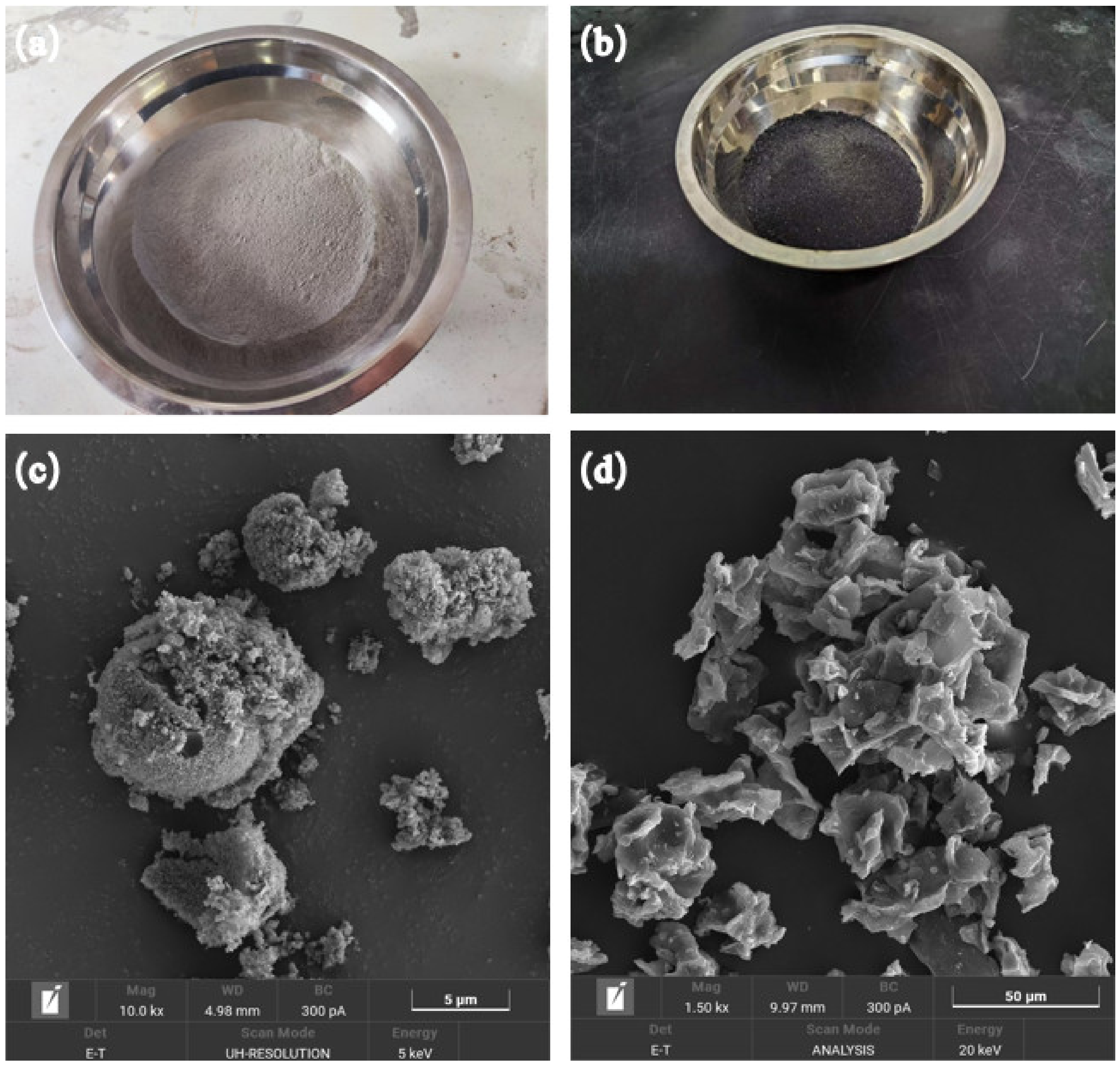
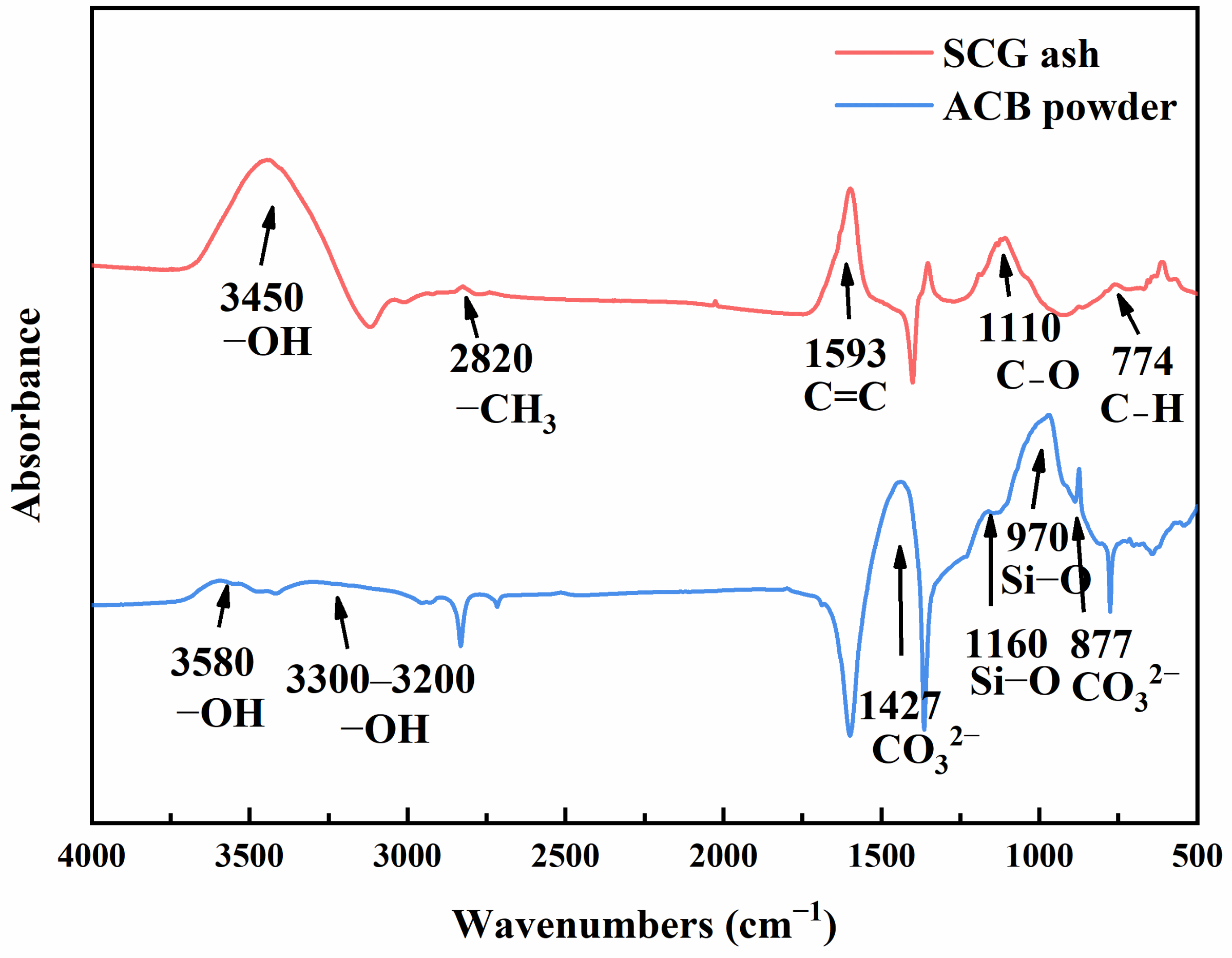
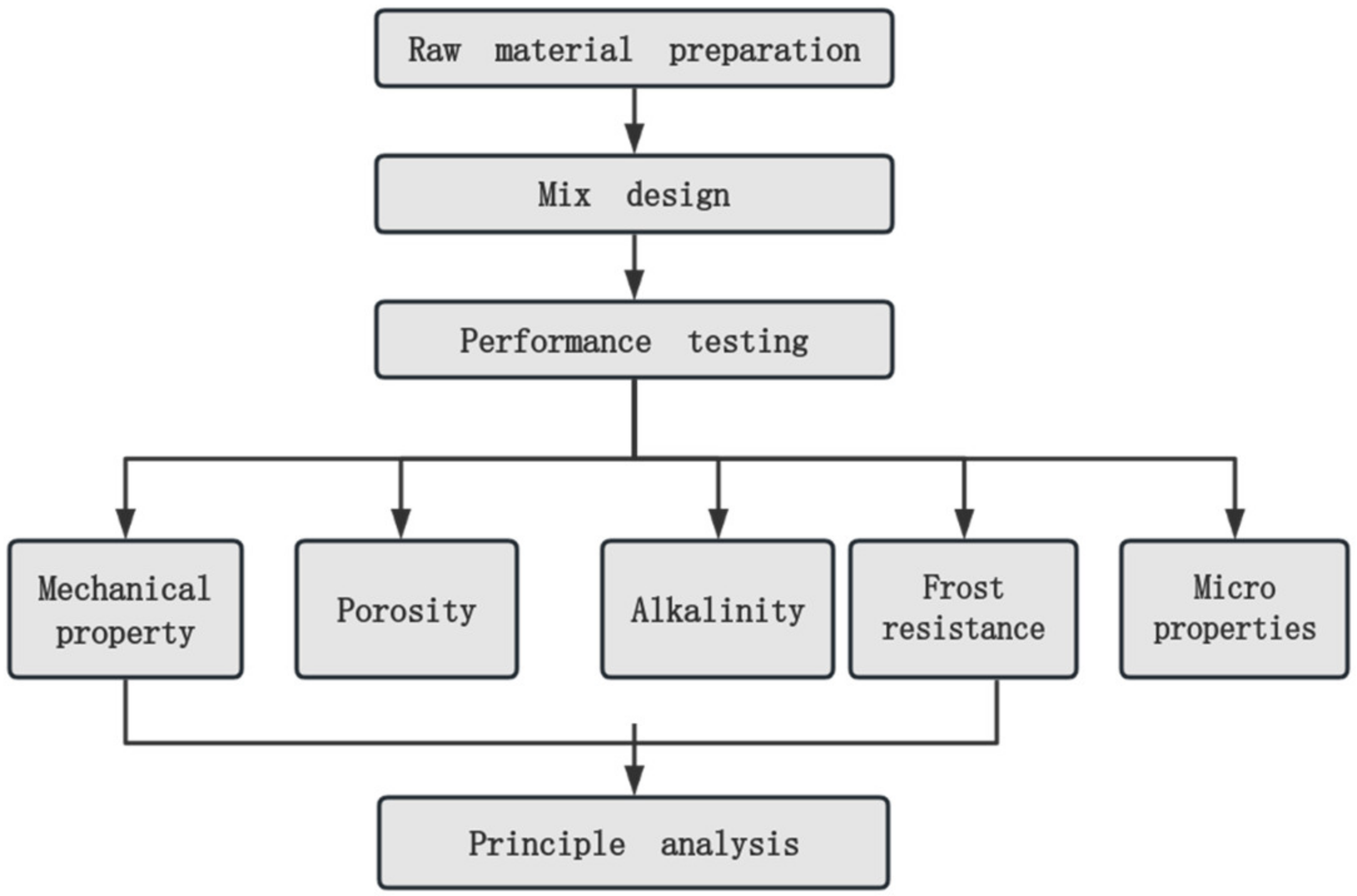

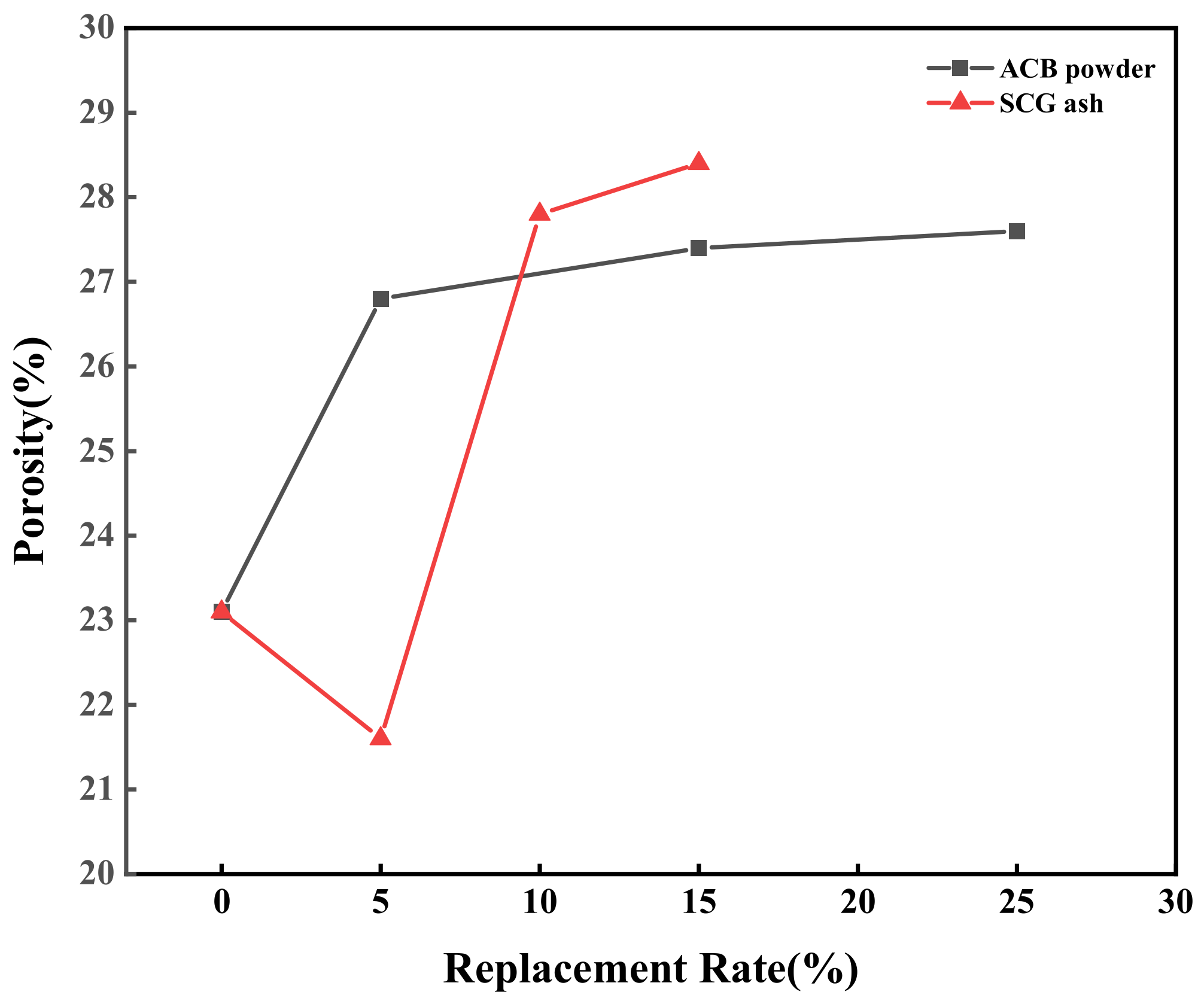

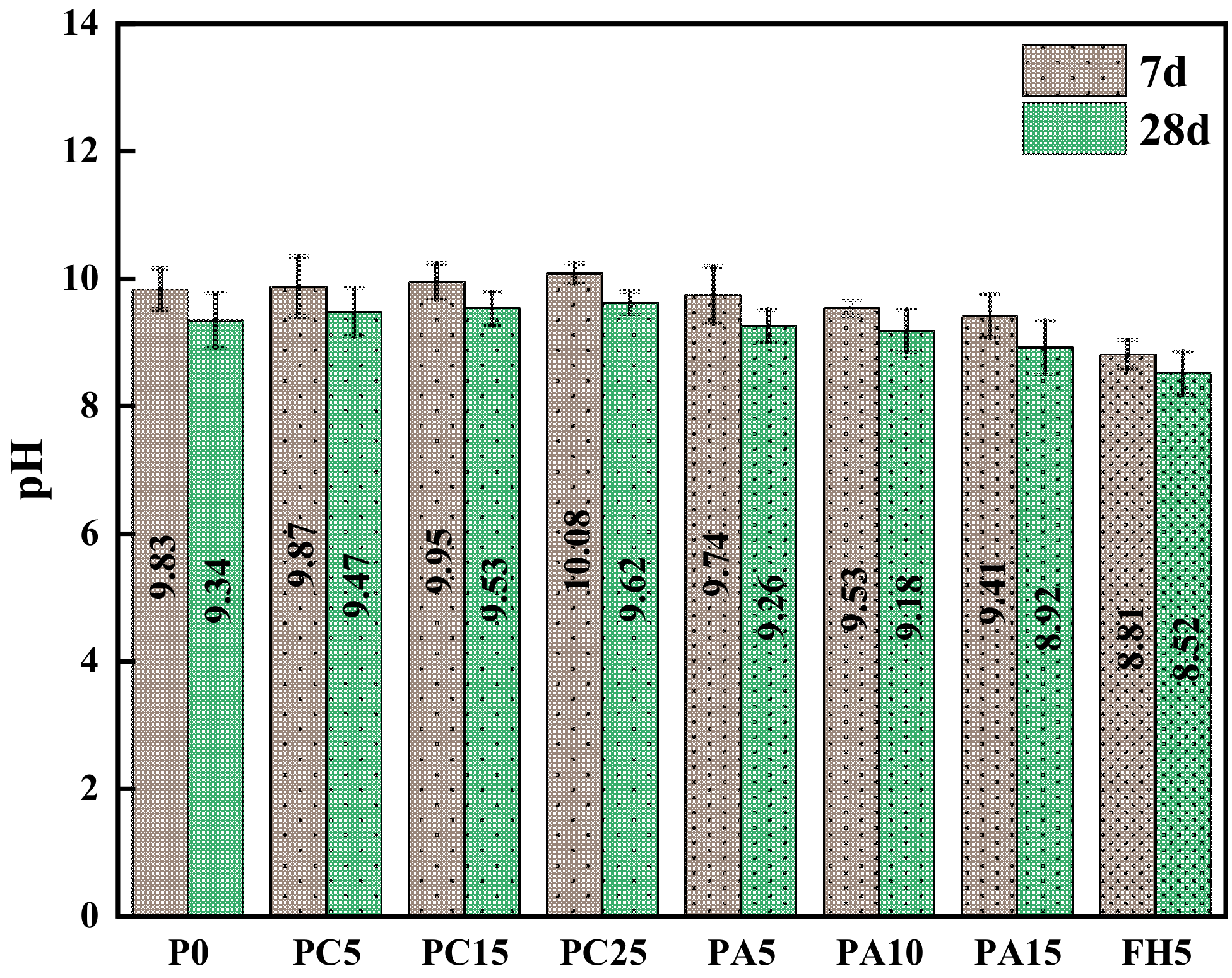
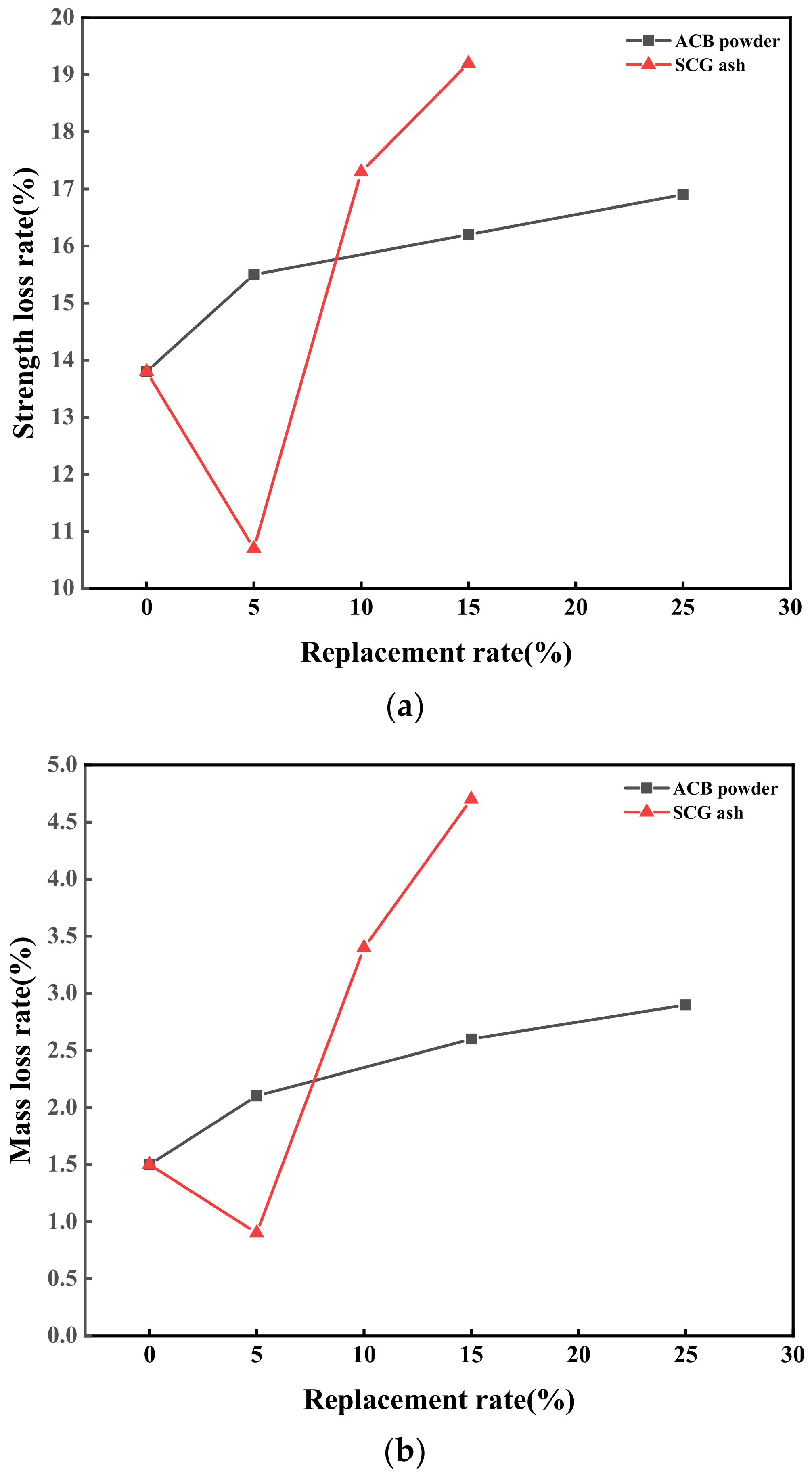

| Specific Surface Area m2/kg | Density g/cm3 | Setting Time/min | Flexural Strength/MPa | Compressive Strength/MPa | |||
|---|---|---|---|---|---|---|---|
| Initial Set | Final Set | 3d | 28d | 3d | 28d | ||
| 458 | 2.76 | 98 | 142 | 3.54 | 7.57 | 21.98 | 44.83 |
| Bulk Density g/cm3 | Apparent Density g/cm3 | Porosity/% |
|---|---|---|
| 0.790 | 2.584 | 68.5 |
| Specific Gravity | Water Absorption/% |
|---|---|
| 0.75 | 15 |
| Oxides | CaO | SiO2 | Al2O3 | Fe2O3 | MgO | SO3 | Loss on Ignition/% |
|---|---|---|---|---|---|---|---|
| Content/% | 21.7 | 54.8 | 5.8 | 2.6 | 1.2 | 4.5 | 9.4 |
| Items | Element | ||||
|---|---|---|---|---|---|
| Carbon (C) | Nitrogen (N) | Hydrogen (H) | Oxygen (O) | Sulfur (S) | |
| SCG (%) | 53.14 | 4.23 | 1.09 | 41.51 | 0.03 |
| SCG ash (%) | 57.69 | 2.49 | 14.98 | 24.83 | 0.01 |
| Numbering | Cement/kg | ACB Powder/g | SCG Ash/g | Gravel/kg | Water/kg | Water Reducer/g |
|---|---|---|---|---|---|---|
| P0 | 6 | 0 | 0 | 30 | 1.8 | 12 |
| PC5 | 5.7 | 300 | 0 | 30 | 1.8 | 12 |
| PC15 | 5.1 | 900 | 0 | 30 | 1.8 | 42 |
| PC25 | 4.5 | 1500 | 0 | 30 | 1.8 | 72 |
| PA5 | 5.7 | 0 | 300 | 30 | 1.8 | 24 |
| PA10 | 5.4 | 0 | 600 | 30 | 1.8 | 60 |
| PA15 | 5.1 | 0 | 900 | 30 | 1.8 | 210 |
| FH5 | 5.4 | 300 | 300 | 30 | 1.8 | 12 |
| Number | Strength/MPa | Activity Index/% | ||
|---|---|---|---|---|
| 7d | 28d | 7d | 28d | |
| Control | 36 | 43 | - | - |
| ACB powder | 30.7 | 38.5 | 85.3 | 89.5 |
| SCG ash | 14.3 | 20.6 | 39.7 | 47.9 |
Disclaimer/Publisher’s Note: The statements, opinions and data contained in all publications are solely those of the individual author(s) and contributor(s) and not of MDPI and/or the editor(s). MDPI and/or the editor(s) disclaim responsibility for any injury to people or property resulting from any ideas, methods, instructions or products referred to in the content. |
© 2024 by the authors. Licensee MDPI, Basel, Switzerland. This article is an open access article distributed under the terms and conditions of the Creative Commons Attribution (CC BY) license (https://creativecommons.org/licenses/by/4.0/).
Share and Cite
Li, J.; Huang, R.; Chen, Z.; Sun, X.; Yu, D. Utilization Potential of Aerated Concrete Block Powder and Coffee Grounds Ash in Green-Growing Concrete. Materials 2024, 17, 3027. https://doi.org/10.3390/ma17123027
Li J, Huang R, Chen Z, Sun X, Yu D. Utilization Potential of Aerated Concrete Block Powder and Coffee Grounds Ash in Green-Growing Concrete. Materials. 2024; 17(12):3027. https://doi.org/10.3390/ma17123027
Chicago/Turabian StyleLi, Jinping, Rong Huang, Zheng Chen, Xuedi Sun, and Deliang Yu. 2024. "Utilization Potential of Aerated Concrete Block Powder and Coffee Grounds Ash in Green-Growing Concrete" Materials 17, no. 12: 3027. https://doi.org/10.3390/ma17123027
APA StyleLi, J., Huang, R., Chen, Z., Sun, X., & Yu, D. (2024). Utilization Potential of Aerated Concrete Block Powder and Coffee Grounds Ash in Green-Growing Concrete. Materials, 17(12), 3027. https://doi.org/10.3390/ma17123027





